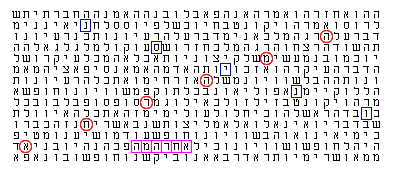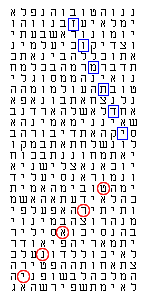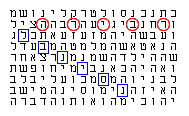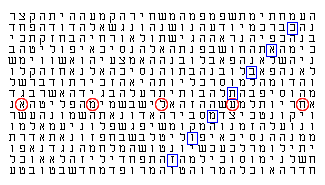
The convergence of א"חרהמה and his date of death, ןסינ ו, in War and Peace.

|
The convergence of ינארט and his date of death, זומת ד"י, in War and Peace. |

The convergence of ר"בירה and his date of death, ןסינב ל, in War and Peace.
We note that there may be a case for removing the name ןידמע altogether, for it is just the name of a town were the Yaabez was briefly a Rabbi, and not his last name. The Yaabez himself wrote in [Ya],
יפב י"רש בעותה ליגרהש ומכ תרגאה ג"ע סערדא ת"כמ השע רשאכ)
ךא 'תוארל הפצמ אלו הב דלונ אל ןידמע ינבמ ינניאש עודי (תוירבה
התע הככ ,האשמ תחת ץבור יתויהב םדקמו זאמכ 'תלעותו 'תבוט שקבמ
...'תנקת לע דקוש ינא
... The busy Yaakov Israel known as Yaabez good omen was never called Yaakov Emdyn (ןידמע) (as has done the honourable in the address on this letter as is the deplorable habit in the tongues of the people). It is known I am not from the people of Emdyn, was not born there, do not expect to see it, but am looking after its welfare and benefit as in the former times when I was under it's load, [and] so also am I now diligent for it's remedy. ...Little did his plea help, and the Yaabez has several common appellations which are variants of the word ןידמע. We keep them in our list.
At this point we got the advice of two wise men. One suggested that we look at [Hei], a book on the Jewish laws in the state of Moravia, where Rabbi Menachem Mendel was the state's Rabbi. From the other wise man we learned to check the citations in the footnotes. One footnote, on page 111 of [Hei], he checked himself. It lead to an article [Marx], that contain a letter written by the son of a nephew of Rabbi Menachem Mendel in the late 17th century, only a few dozen years after Rabbi Menachem Mendel died in 1661. In that letter Rabbi Menachem Mendel's surname is given as לאמחארק. The following day (and a continent away), we checked the footnote on page 102. It lead us to two articles, [Har] and [Ka], devoted to our Rabbi and his descendents. Both articles use the spelling לאמכארק extensively and not just in passing, and the latter one even explains where the name comes from! It relates the name לאמכארק to a certain earlier Dayan, Rabbi Jonah Krochmals in the city of Cracow, where Rabbi Menachem Mendel was born. A transcript of the tombstone of Rabbi Jonah Krochmals is given in [Zo, page 180] and Krochmals is spelled שלאמכארק there. Thus there is no doubt that the original spelling of the name Krochmal is לאמכארק and we remove the appellation למכורק from our list, putting לאמכארק instead.
Note that here we corrected new to old, while in the case of Rabbi II-25, Rabbi Yitshak HaLevi Horowitz we corrected old to new. Whatever inconsistencies WRR have we are allowed to have too.
We also note that once it is clear that לאמכארק is an acceptable spelling for Krochmal, the usage of this spelling is mandatory according to the WRR rules, which state explicitly that Yiddish names are spelled as in the original Yiddish. Recall that לאמכארק is a Yiddish word.
The story doesn't end there. When we tried to find ר"עה ח"א as a signature in Rabbi Ricchi's books, we failed. What we did find was a different permutation of these letters, רח"עהא, which appears with its expansion, יקיר יח לאונמע ריעצה ינא (me the young, Immanuel Hai Ricchi). We note that in Hebrew the latter expansion makes much more sense than the former, and that the dictionary of acronyms [AY] lists the latter acronym but not the former. Including "רח"עהא" as an appellation is senseless for the same reasons as above, but it still makes more sense than including "ר"עה ח"א". So we deleted "ר"עה ח"א" and inserted "רח"עהא".
After the first version of this note was widely circulated, we finally found a single reference to the variation ר"עה ח"א, in [Shi]. That source refers to an acronym that appears as a signature on an addendum, only available in Zurich, to Rabbi Ricchi's book "בשוח השעמ". Neither the original edition of that book, nor any of his other books that we checked, contain that acronym; the original edition of "בשוח השעמ", like many of Rabbi Ricchi's other books, contains רח"עהא. We don't have the resources to check the manuscript in Zurich, so at the moment we don't know if the acronym ר"עה ח"א really appears there or if [Shi] copied it with the ח misplaced. However, we can see two things clearly: if the acronym ר"עה ח"א exists at all it is a signature and not an appellation, and the WRR claim to have admitted only widely used pronounced acronyms is false.

The convergence of אמלעח and his date of death, זומתב א"כ, in War and Peace.